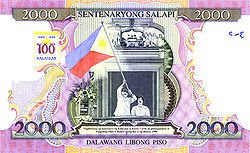2000-peso centennial commemorative banknote. Legal Tender.Here's the bill with a 500-peso bill. It's really huge!Although legal tender, it's very impractical to actually use (why would you use it in the first place?)


Ten Thousand Peso Commemorative Gold Coin (1992)
6th Anniversary - Restoration of DemocracyObverse: President Corazon C. Aquino; Republic of the Philippines, 10000 PesosReverse: Philippine map superimposed on Constitution and dove of peace flying towards the light; Democracy Restored; VI Anniversary; 1986, 1992Shape: roundEdge: reededMaterial: goldThis is the largest coin denomination ever issued in the Philippines. I am still looking for more information on this very rare coin.

One Hundred Thousand Piso Commemorative Banknote
photo from Torres Batch65
This banknote was issued during the Centennial of Philippine Independence in 1998. It is as large as a legal-sized bond paper. Produced in Germany, the banknote has 21 security features including a hologram, making it very hard to counterfeit. On release, this collector's item was sold at P180,000. Today, it is worth many times more. It is recognized by the Guiness Book of world Records as the world's largest legal tender banknote.


























